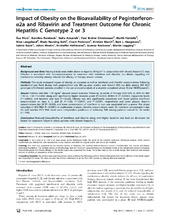| dc.description.abstract | Background and Aims: Having a body mass index above or equal to 30 kg/m2 in conjunction with chronic hepatitis C virus infection is associated with non-responsiveness to treatment with interferon and ribavirin, but details regarding the mechanisms whereby obesity reduces the efficacy of therapy remain unclear. Methods: This study evaluated impact of obesity on outcome as well as interferon and ribavirin concentrations following standard-of-care fixed dosing with peginterferon-α2a 180 µg once weekly and ribavirin 800 mg daily among 303 HCV genotype 2/3-infected patients enrolled in the per-protocol analysis of a recently completed phase III trial (NORDynamIC). Results: Patients with BMI ≥30 kg/m2 showed poorer outcome following 24 weeks of therapy (SVR 62% vs. 89% for BMI ≥30 vs. <30; P = 0.006) along with significantly higher steatosis grade (P = 0.002), HOMA-IR (P<0.0001), triglyceride levels (P = 0.0002), and baseline viral load (P = 0.028). Obesity was also significantly associated with lower plasma interferon concentrations on days 3, 7, and 29 (P = 0.02, P = 0.0017, and P<0.0001, respectively) and lower plasma ribavirin concentrations day 29 (P = 0.025), and lower concentration of interferon in turn was associated with a poorer first phase reduction in HCV RNA (P<0.0001). In multivariate analysis, ribavirin concentrations week 12, interferon concentrations day 29, and baseline HCV RNA levels were independent predictors of achieving SVR among patients treated for 24 weeks (n = 140). Conclusions: Reduced bioavailability of interferon and ribavirin along with higher baseline viral load are dominant risk factors for treatment failure in obese patients with chronic hepatitis C. | en_US |

